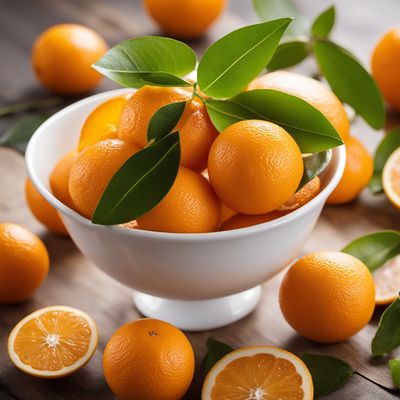
Ingredient
Cleopatra mandarins
The Citrus Jewel: Discover the Allure of Cleopatra Mandarins
Cleopatra mandarins are small to medium-sized citrus fruits with a smooth, thin, and easily peelable skin. The flesh is juicy, tender, and segmented, offering a burst of refreshing sweetness with a subtle tang. The vibrant orange color of the fruit is visually appealing, and the aroma is fragrant and citrusy. These mandarins are known for their seedlessness, making them a convenient and enjoyable snack.
Origins and history
Cleopatra mandarins are believed to have originated in Southeast Asia, specifically in China and Vietnam. They were introduced to the Mediterranean region during the 19th century and gained popularity in Egypt, where they were named after the legendary queen Cleopatra. These mandarins have since spread to various parts of the world, including the United States, where they are now cultivated in California.
Nutritional information
Cleopatra mandarins are a rich source of vitamin C, providing a significant boost to the immune system. They also contain dietary fiber, potassium, and antioxidants, while being low in calories, making them a healthy and nutritious choice.
Allergens
Cleopatra mandarins are not known to be associated with any common allergens.
How to select
When selecting Cleopatra mandarins, look for fruits that are firm, heavy for their size, and have a smooth and glossy skin. Avoid any mandarins with soft spots, blemishes, or signs of mold. The best-quality mandarins will have a vibrant orange color and a fragrant aroma.
Storage recommendations
To maintain the freshness and quality of Cleopatra mandarins, store them in a cool, dry place away from direct sunlight. They can also be refrigerated for up to two weeks. It is best to consume them within a few days of purchase for optimal flavor.
How to produce
Cleopatra mandarins can be grown by amateur gardeners in regions with a Mediterranean climate or similar conditions. They require well-drained soil, full sun exposure, and regular watering. Planting a grafted tree or starting from seeds are both viable options for producing these mandarins.
Preparation tips
Cleopatra mandarins can be enjoyed as a refreshing snack on their own or incorporated into various dishes. They can be segmented and added to salads, desserts, or smoothies. The zest and juice of these mandarins can be used to enhance the flavor of sauces, marinades, and baked goods. To extract the juice, simply roll the mandarin on a hard surface to loosen the juice, then cut and squeeze.
Culinary uses
Cleopatra mandarins are commonly used in both sweet and savory dishes. They add a burst of citrus flavor to salads, dressings, and marinades. The juice and zest can be used in desserts such as cakes, tarts, and sorbets. Cleopatra mandarins also make a refreshing addition to cocktails and mocktails.
Availability
Cleopatra mandarins are commonly available in regions with a Mediterranean climate, such as California in the United States.
More ingredients from this category

Clementines
Sunshine in a Peel: Clementines

Tankan mandarin
The Citrus Jewel

Mediterranean mandarins
Sun-Kissed Citrus Delight

Tangors
The Zesty Hybrid: Unveiling the Tangors' Citrus Symphony

Minneolas
The Citrus Gem

Other hybrids of Citrus reticulata, not elsewhere mentioned
Citrus Reticulata Hybrids: Unveiling the Zesty World of Citrus Delights

Mandarins
The Citrus Jewel

Satsumas
Sweet and Tangy Citrus Delights

Tangerines
The Tangy Delight

Calamondins
The Zesty Jewel of Citrus